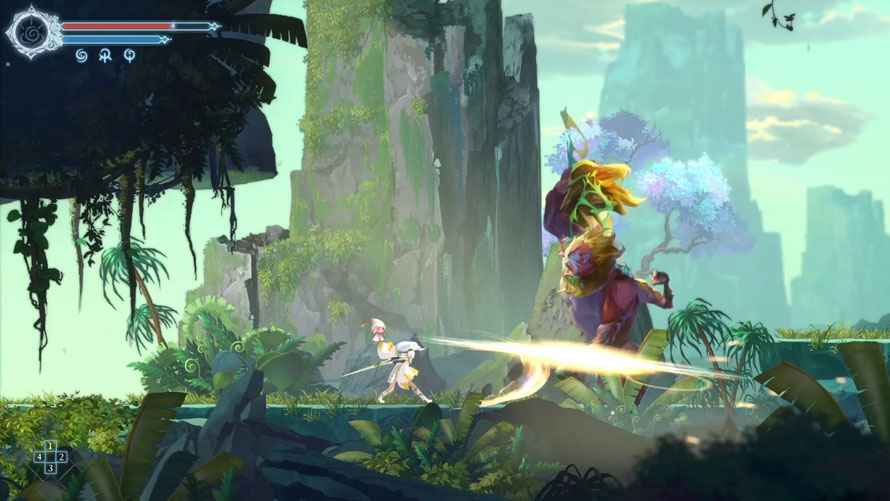Afterimage Preview
The other day I was stuck in line at the grocery store, staring at the rack of impulse items. You know, fingernail clippers, lip balm, knockoff earbuds, and candy. Lots of candy, perfect for silencing fussy children or fueling sugar-starved adults. I thought, I’m sure glad I’m not a candy designer. What can you do with chocolate and nuts that hasn’t been done before? In a way, 2D action games are like that. What can a new Metroidvania bring to the table? In the case of Afterimage, quite a lot.
Hand Painted Platforming
Funded via a hugely successful Kickstarter campaign, Afterimage is nearing full release in April. While it doesn’t reinvent a very popular genre, it might have enough standout features to place it in the “must-play” column for 2D action fans.
The most immediately striking aspect of Afterimage is its art design, which is painterly and colorful. The fantasy world of Engardin and the principal character Renee are appealing, with a bit of anime flavor to their appearance. Although Engardin appears at first to be benign and bucolic, it is filled with dangerous beasts and monsters. The opening areas are colorful and gentle. Later levels descend into caves and darker environments.
Afterimage’s map is full of shortcuts, switchbacks, and hidden areas. Exploring is a decidedly non-linear experience, and it’s easy to get a little lost, even with the map. There are relatively few save and respawn points, too, which can be frustrating. Afterimage doesn’t punish the player too badly for dying, however, except for rewinding to a save point.

Beasts and Battles
Afterimage is not an easy game. Even relatively low-level enemies possess unique moves, attack patterns, and special abilities. Some are swift, others attack from the air, and many have powerful ranged attacks. After the first, brutal boss, both the game world and the player’s abilities open up. Renee starts the game with few weapons and defenses, over time her power increases. These are the characteristics of most Metroidvanias. In the case of Afterimage, Renee draws from an especially deep and wide upgrade grid. Though it takes a while for those abilities and upgrades to kick in, eventually combat really starts to click.
Often, a Metroidvania depends on the player character being especially mobile. Afterimage is no different. Somewhere up in the talent tree, Renee opens up fast movement, air dashes, and double jumps. Afterimage’s platforming is good, with jumps usually finding a sweet spot between precision and forgiving of us timing-challenged players. Like a Soulslike, Afterimage uses a health and stamina system. There is no blocking mechanism, however, with Renee relying on dodges to evade attacks.
Promises, Promises
For a game still, a few months away from release, Afterimage has winning art and combat. Its story and writing are less stellar. I was a bit disappointed by the “amnesiac hero in a corrupted world” premise. I wouldn’t say that the narrative is incomprehensible, but it’s definitely opaque and takes a back seat to the action. Likewise, the game’s audio design and music are serviceable but not memorable. I am interested to see where the story goes and how the game’s action develops even further.

If I had a wish list for Afterimage, it would include a bit of mechanical fine-tuning, another pass at balancing the difficulty, and maybe some fine-tooth-combing over the texts and translations. As it stands, though, Afterimage is an engaging and artistic Metroidvania. It’s attractive and enjoyable enough to stand out in a deluge of similar games, which is already an accomplishment. I look forward to seeing where Afterimage takes me when it releases on April 25.
Thank you for keeping it locked on COGconnected.
- For amazing videos, head over to our YouTube page HERE.
- Follow us on Twitter HERE.
- Our Facebook page HERE.
- Our Instagram page HERE.
- Listen to our podcast on Spotify or anywhere you listen to podcasts.
- If you are a fan of cosplay, check out more of our cosplay features HERE.

